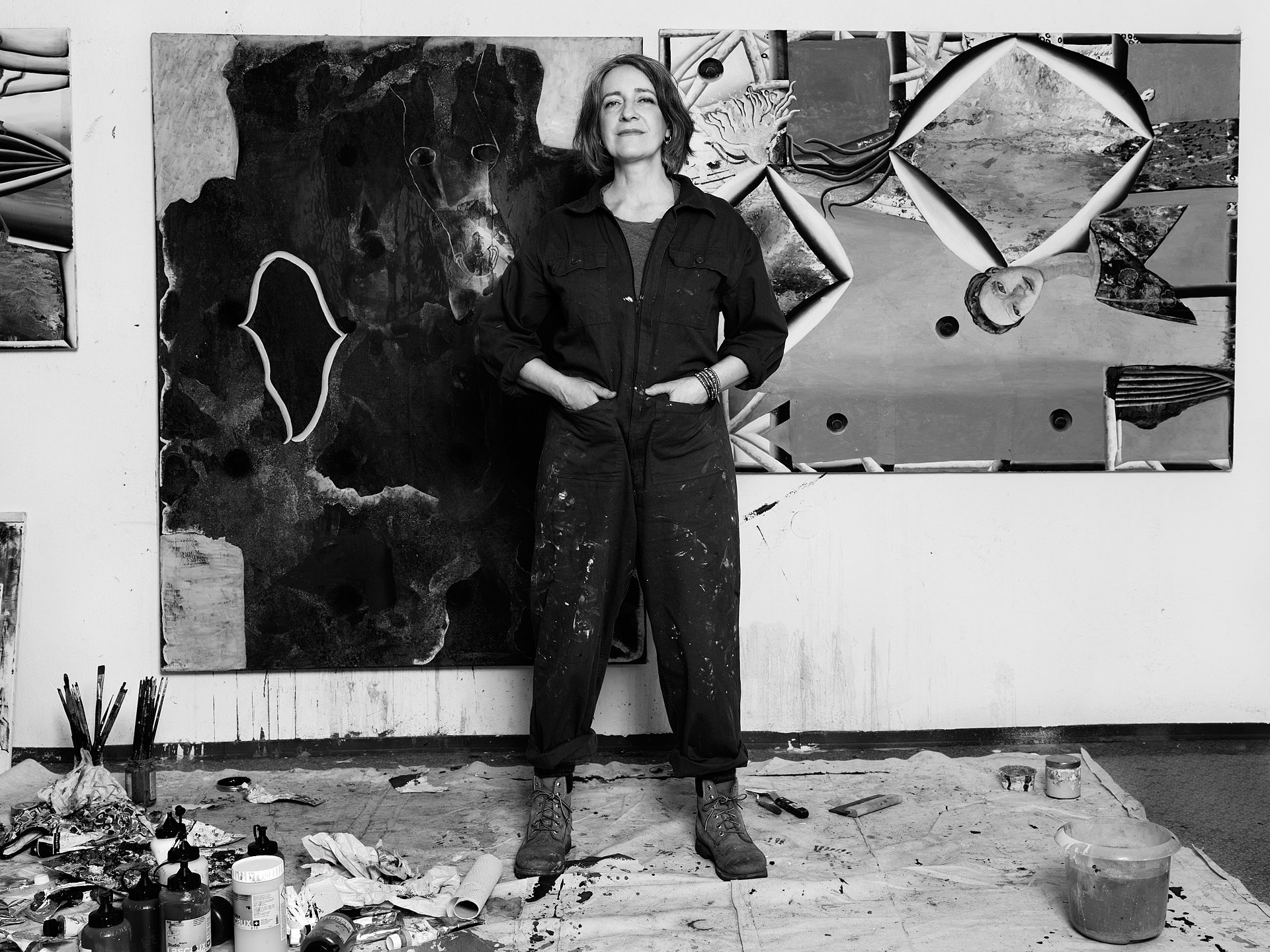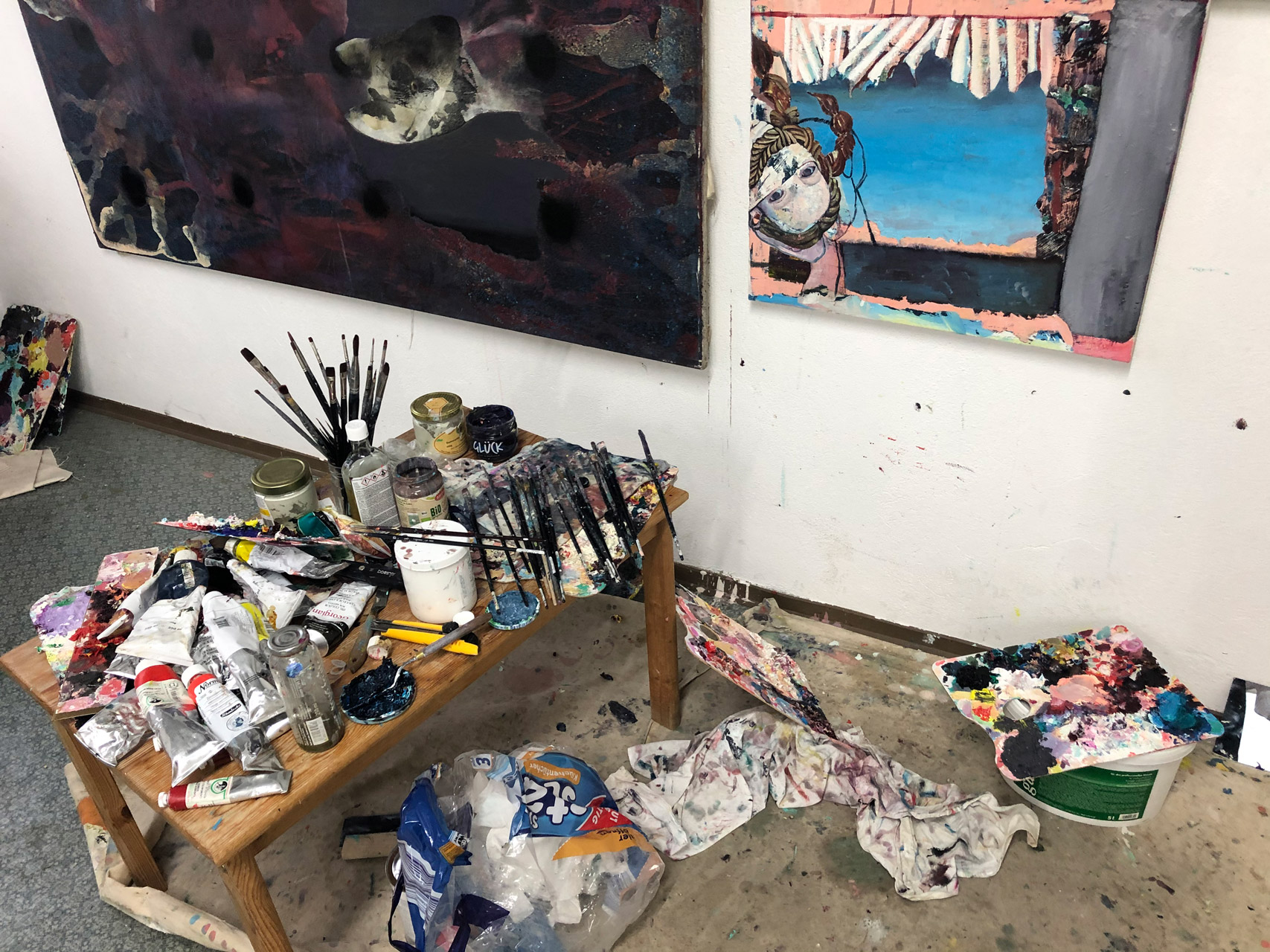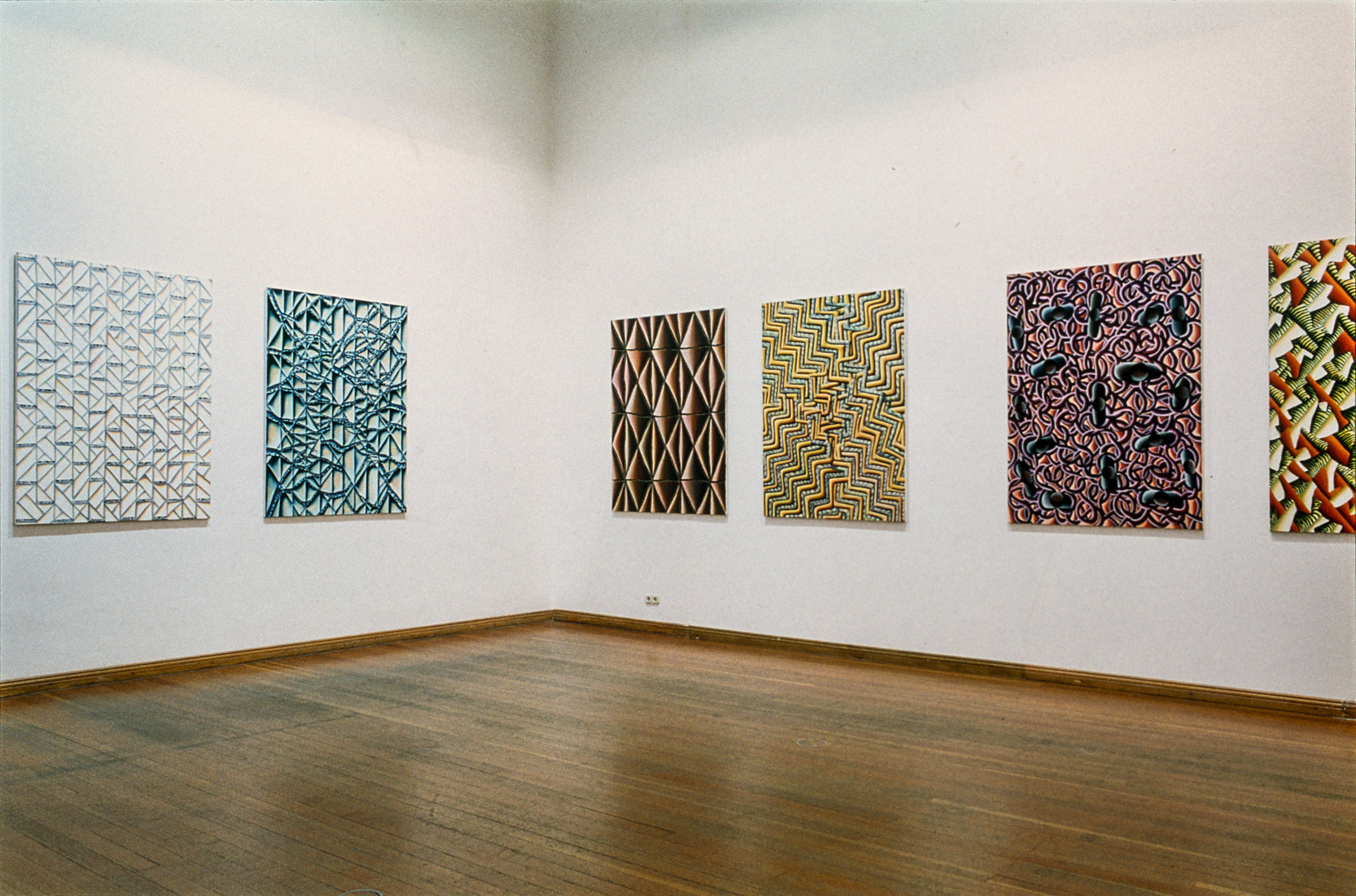About Christine Krämer
Born 1959 in Copenhagen of her Danish mother and her German father who worked internationally, Christine grew up in India, Denmark and Germany. Throughout her entire life she approached the world through painting and consequently studied Free Painting at the University of Arts (UDK) in Berlin. After she received her Master of Arts from she worked successfully in her Berlin studio, resulting in national and international exhibitions and a number of prestigious scholarships.
At thirty-five Christine adopted and raised three children and is living and working today in a village just outside Berlin.
How I work
My work is about reflecting on my perception of so-called reality and expanding it as a result. I am interested in a process and not in the representation of something experienced. I want to create experiences. I have always been addicted to the possibility of reinterpreting everything I encounter. For example, I love to see a landscape in a spot, knowing that it is not a landscape. The connection between the immediacy of the color and the idea is very important to me in its paradox. The kind of reception through a simultaneous different interpretation of one thing (color spot and landscape in one) triggers a very liberating irritation. It creates a state of euphoria.
I suspect that such a procedure offers a possibility to allow different dimensions of perception at the same time – memories, conceptual review and vision emanating from the image take place simultaneously. Through my ongoing preoccupation with this process, I am able to allow other states and recognize the usual section of the three-dimensional world in its limitations and relativity.
For my artistic work, this means in particular an approach that combines both the acceptance of chance and a simultaneous, critical conceptual approach. In my case, chance means randomly feeding the canvas with paint and then staring at the picture until it offers an approach for the realization of my concept. So it’s an alternating process between painting following the concept and painting without having the slightest idea what I am doing:
I don’t know what it’s about myself. I don’t really know how these particular forms come about. I’m not by that suggesting that I’m inspired or gifted. I just don’t know. I look at them – I look at them, probably, from an aesthetic point of view. I know what I want to do, but I don’t know how to do it. And I look at them almost like a stranger, not knowing how these things have come about and why have these marks that have happened on the canvas evolved into these particular forms. And then, of course, I remember what I wanted to do and I do, of course, try then and push these irrational forms into what I originally wanted to do.
(from: David Sylvester – Conversations with Francis Bacon, 1982)
Whenever I paint something that I don’t understand at all, I am particularly sure that it will succeed. This simultaneity of instinctive feeling and intentional action allows me to be both player and spectator at the same time.
To all appearances, the artist acts like a mediumistic being who, from the labyrinth beyond time and space, seeks his way out to a clearing.
(Marcel Duchamp, 1958)
In meiner Arbeit geht es mir darum, über meine Wahrnehmung von sogenannter Realität nachzudenken und sie dadurch zu erweitern. Ich bin an einem Prozess interessiert und nicht an der Darstellung von etwas Erlebten. Ich möchte Erlebnisse herstellen. Ich bin seit jeher süchtig nach der Möglichkeit, alles was mir begegnet umzudeuten. Ich liebe es z.B. in einem Fleck eine Landschaft zu sehen, wissend dass es keine Landschaft ist. Die Verbindung von Unmittelbarkeit der Farbe und Idee ist mir in ihrer Paradoxie sehr wichtig. Die Art der Rezeption durch eine gleichzeitige unterschiedliche Deutung von einem Ding (Farbfleck und Landschaft in einem) löst eine sehr befreiende Irritation aus. Es erzeugt gerade zu einen euphorischen Zustand.
Ich vermute, dass solch ein Vorgehen eine Möglichkeit bietet, unterschiedliche Dimensionen von Wahrnehmung gleichzeitig zuzulassen – Erinnerungen, konzeptuelle Überprüfung und vom Bild ausgehende Vision finden zeitgleich statt. Durch meine dauerhafte Beschäftigung mit diesem Vorgang gelingt es mir andere Zustände zuzulassen und den üblichen Ausschnitt der dreidimensionalen Welt in seiner Begrenztheit und Relativität anzuerkennen.
Für meine künstlerische Arbeit bedeutet das im Besonderen ein Vorgehen, was sowohl das Hinnehmen von Zufälligem und die gleichzeitige, kritische konzeptuelle Vorgehensweise verbindet. Zufall bedeutet in meinem Fall das willkürliche Füttern der Leinwand mit Farbe, um dann so lange auf das Bild zu starren, bis dieses einen Ansatz für die Umsetzung meines Konzeptes anbietet. Es ist also ein wechselnder Prozess zwischen dem Konzept folgendem Malen und dem Malen, ohne die geringste Ahnung zu haben, was ich da tue:
Ich weiß es einfach nicht. Ich schaue Sie (die Farbspuren auf der Leinwand) an – ich betrachte Sie vermutlich aus einem ästhetischen Blickwinkel. Ich weiß was ich machen will, aber ich weiß nicht, wie es zu tun ist. Und ich schaue sie fast wie ein Fremder an, ohne Kenntnis wie diese Dinge entstanden sind, und warum die Spuren, die auf der Leinwand entstanden sind, sich zu diesen eigentümlichen Formen entwickelt haben. Und dann fällt mir natürlich ein, was ich tun wollte, und ich versuche, diese irrationalen Formen das werden zu lassen, was ich ursprünglich wollte.
(aus: David Sylvester – Gespräche mit Francis Bacon, 1982)
Immer wenn ich etwas male, was ich überhaupt nicht verstehe, bin ich mir besonders sicher, dass es gelingen wird. Diese Gleichzeitigkeit von instinktiver Empfindung und intentionalem Vorgehen lässt mich gleichzeitig Spieler und Zuschauer sein.
Es hat allen Anschein, als ob der Künstler wie ein mediumartiges Geschöpf handelt, das aus dem Labyrinth jenseits von Zeit und Raum seinen Weg ins Freie sucht.
(Marcel Duchamp, 1958)
Vita
Solo Exhibitions
| 2023 | StudioShow #2, with Sid Gastl, Berlin | |
| 2022 | Perdu – Marienkirche, Müncheberg | |
| How to paint a code – Brotfabrik, Berlin | ||
| 2021 | Malerei und Fotografie – Kunst im Westend, Berlin | |
| Heute da, morgen hier – Dorfkirche Hoppegarten, Hoppegarten | ||
| 2020 | Malerei und Fotografie – Kunst im Westend, Berlin, with Annemarie Freybourg | |
| 2019 | The Blue Hour – Brotfabrik, Berlin, with Christoph Tannert | |
| 2018 | Horses – Fotografie, Ashgabat, Turkmenistan | |
| 2016 | Ambilateral – Kunstverein Schul- und Bethaus Altlangsow, with Christoph Tannert und Almut Kühne | |
| 2015 | Bildcode – Galerie Oqbo Berlin, with Katharina Karrenberg | |
| 1999 | Malerei – Kunst auf dem Campus, Max-Delbrück-Zentrum, Berlin | |
| 1995 | Christine Krämer – Galerie Busche, Berlin | |
| 1994 | Painting – Galerie Vinzenz Sala, Berlin |
Group Exhibitions
| 2022 | 4. Weißenseer Kabinettausstellung – Brotfabrik, Berlin | |
| 2020 | Grande Finale – Weissenseer Kabinet, Brotfabrik Galerie, Berlin | |
| 6 aus 181 – Galerie Oqbo, Berlin | ||
| 2018 | Ene-mene-muh… – Bar Babette, Berlin | |
| Brandenburger Kunstpreis – Schloss Neuhardenberg | ||
| 2016 | Cross Section 1 – Galerie Busche, Berlin,Hanne Darboven, Alexandra Baumgartner u.a. | |
| Galerie Oqbo Paperfile – Bildersaal Artothek, Munich | ||
| 1998 | Fünf malerische Positionen – Galerie Busche, Berlin | |
| Junge Kunst International – Overbeckgesellschaft, Lübeck, catalog | ||
| 1997 | Korrespondenzen – Berlinische Galerie, Berlin, catalog | |
| Korrespondenzen – Scottish National Gallery of Modern Art Edinburgh with Richard Wright, Veronika Kellndorfer, Fischer el Saani, Nathan Coley et al., catalog | ||
| 1996 | Panoptik – Alt-Stralau, Berlin | |
| 1993 | Kunst-Sprache – KunstWerke (KW), Berlin | |
| 1992 | Was der Mensch so braucht – Bergmannstr. 110, Berlin, catalog | |
| 1991 | Ohne Kompromiss – Goldrausch Künstlerinnenprojekt, Bethanien Berlin, catalog | |
| 9 Hasenheide 9 – Kunstamt Kreuzberg, Bethanien, Berlin, catalog |
Collections
– Sammlung der Berlinischen Galerie – Berlin
– Sammlung des Max Delbrück Zentrums – Berlin
– Neuer Berliner Kunstverein
– Artothek Berlin
– Private Collections
Scholarships
| 2021 | Projektförderung Modul C, “How to Paint a Code”, Neustart Kultur, BBK Bundesverband | |
| 1998 | Arbeitsstipendium, Kunstfond, Berlin | |
| 1997 | Arbeitsstipendium, Kunstfonds e.V., Bonn | |
| 1993 | Arbeitstipendium, Senat für kulturelle Angelegenheiten, Berlin | |
| 1992 | Stipendium, Senatsverwaltung für kulturelle Angelegenheiten von Frauen, Berlin | |
| 1991 | Goldrausch Künstlerinnenförderung, Berlin | |
| 1990–94 | Work contracts with the Berlin Senate of Culture |








